The dumbbell row is one of the single most effective back exercises you can do.
It also goes by many names, including the bent-over dumbbell row, one-arm dumbbell row, dumbbell bench row, and dumbbell single-arm row.
And while some weightlifters make subtle distinctions between these variations, they all describe more or less the same, highly-effective back exercise—you grab a dumbbell in one arm, learn forward, and pull it toward your torso.
Although it might sound simple (and it is), proper dumbbell row form is still key—you have to know how to do a dumbbell row correctly if you want to get the most out of the exercise.
In this article you’ll learn the benefits of the dumbbell row, exactly how to do a dumbbell row, some tips on how to make it as effective as possible, the best dumbbell row variations there are, and more!
Let’s begin.
Dumbbell Row Benefits
One of the reasons the dumbbell row is such a great exercise is it trains all the muscles of the back, such as the . . .
- Latissimus dorsi
- Trapezius
- Rhomboids
- Teres major and minor
- Posterior deltoids
- Infraspinatus
- Erector spinae
. . . and it trains your biceps and forearms, too.
Here’s a graphic showing the muscles worked by the dumbbell row (sans the biceps and forearms):

Another reason the dumbbell row is such a boon for your back is that it allows you to train one side of your body at a time (it’s what’s known as a unilateral exercise).
This is beneficial because it . . .
- Enables you to lift a little more total weight than you’d be able to with a barbell row. (For example, if you can barbell row 200 pounds, you might be able to dumbbell row 105 pounds in each hand).
- Helps you develop a greater mind-muscle connection with your back muscles, because you only need to focus on one side of your body at a time.
- Helps you correct muscle imbalances, because both sides of your body are forced to lift the same amount of weight (one side can’t “take over” from the other).
How to Dumbbell Row with Proper Form
To get started, make sure you have all the equipment you need to do the dumbbell row correctly, including . . .
- A set of dumbbells (you’ll need an adjustable set or access to a gym with a full selection of dumbbells)
- A sturdy bench
- A pair of weightlifting straps (optional)
With that taken care of, let’s talk about how to do a dumbbell row with proper form.
Step 1: Set Up
Hold a dumbbell in your weaker hand (if you’re right-handed, this is probably your left hand, and vice versa).
Bend over at the waist and plant your right knee and arm firmly on a bench, your left foot on the floor a foot or two from the bench, and let your left arm (the one holding the dumbbell) hang straight down toward the floor. Your back should be close to parallel to the ground and your weight should be evenly distributed across your right hand, right knee, and left foot.
Step 2: Ascend
Keeping your back straight, pull the dumbbell upward until it touches your torso somewhere between the top of your hip and base of your ribs.
Note: If you’re using a heavy dumbbell (as you should), you’ll probably find it helpful to slightly rotate your upper body in order to generate enough momentum to complete the rep. While some people look at this as “cheating,” it actually makes the exercise more effective by allowing you to train your back muscles through a greater range of motion with heavier weights.
Step 3: Descend
Lower the dumbbell toward the ground and return to the starting position.
As you lower the dumbbell, let it drift slightly forward and rotate your body toward the ground so that you feel a deep stretch in your lats.
Quick note: One set of a single-limb exercise entails training both limbs. For instance, you’ve completed one set of 10 reps of the one-arm dumbbell row when you’ve done 10 reps for each arm.
Dumbbell Row Tips
Tip #1: Lean on a bench
The most comfortable and stable way to do the dumbbell row for most people is how I described it above—bracing one knee and hand on a bench and the opposite foot on the floor.
That said, if all of the benches are occupied or you just want to try something different, you can also lean on another surface such as the dumbbell rack. To do this, plant your feet about shoulder-width apart, bend over at the waist, place one hand on the dumbbell rack (or other surface), and use your opposite hand to pull the dumbbell to your chest.
The key to making this work, though, is to ensure your torso is almost parallel to the floor. If your torso is too upright you won’t be able to achieve the same range of motion, and the exercise won’t be as effective.
Tip #2: Use weightlifting straps
As you get stronger at the dumbbell row, you’ll probably reach a point where your grip gives out before your back muscles are tired (this is especially true if you’re doing sets of more than ~6 reps).
While some purists say you should keep hammering away with the same weight and reps until your grip strength catches up to your back strength, I think a better solution is to use weightlifting straps.
This allows you to keep adding weight and reps over time and thus build your back and arm muscles more quickly and efficiently (which is the whole goal of the dumbbell row, after all).
Weightlifting straps consist of a single strip of cloth or leather that you can loop into a lasso shape and wrap around a bar or dumbbell to “lock” it to your hand. This reduces the amount of grip strength you need to maintain your hold on the dumbbell, allowing you to keep doing reps until your back muscles are sufficiently trained.
Tip #3: Cheat correctly
Normally, moving your body to generate momentum while weightlifting just reduces the effectiveness of the exercise and leads to worse muscle and strength gains. A few common examples are swinging your torso wildly while doing barbell curls or side raises and doing kipping pull-ups instead of traditional pull-ups.
The dumbbell row is an odd exception to this rule.
The reason for this is that dumbbell have a strange resistance curve, which refers to how hard an exercise feels at different points throughout a rep. Dumbbell rows feel easiest when you’re strongest (at the bottom of each rep) and feel hardest when you’re weakest (at the top of each rep).
This means you may struggle to finish the top portion of a rep even though the rest of the rep feels relatively easy. Thus, if you stop your sets when you begin to struggle with the top of each rep, you’ll be leaving gains on the table.
The solution to this problem is to use a little momentum to make the top portion of the rep easier. This allows you to use a full range of motion throughout each rep and do more total reps before ending your sets (which will lead to more muscle and strength gain over time).
Just make sure you’re only generating enough momentum to complete each rep. Doing more than this just makes the entire rep easier and thus less effective.
Here’s an example of someone using the proper amount of momentum during the dumbbell row:

Tip #4: Start every set with your weaker side
To help minimize muscle imbalances between your right and left side, I recommend you start every set of dumbbell rows with your weaker side. Then, when you switch hands to train your stronger side, only do as many reps as you got with your weaker side.
This way, your weaker side has a chance to catch up to your stronger side, thus correcting any muscle or strength imbalances. Once you can get the same number of reps with both sides, feel free to start your sets with whichever arm you prefer.
The 5 Best Dumbbell Row Variations
Variation 1: Meadows Row
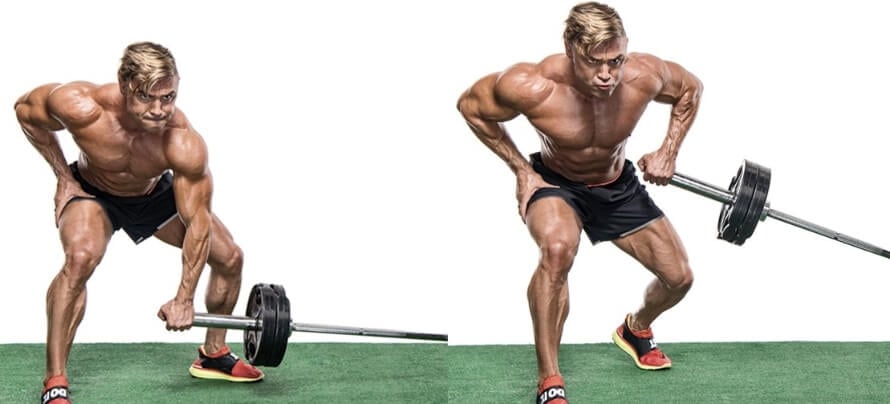
Wedge one end of a barbell into the corner of the room or insert it into a landmine attachment and load the other end with weight. Position your right foot perpendicular to the weighted end of the barbell and your left foot two to three feet behind your right (staggered stance). Your shoulders should form a straight line with the barbell.
Bend over at the waist so your back is almost parallel with the floor and grab the very end of the barbell with your left hand. Then, pull the bar until your hand touches your torso, and lower the bar to the starting position. Once you’ve completed the desired number of reps, repeat on your right side.
Tip: You may need to use lifting straps to maintain your grip on the barbell.
Variation 2: Chest-Supported Dumbbell Row
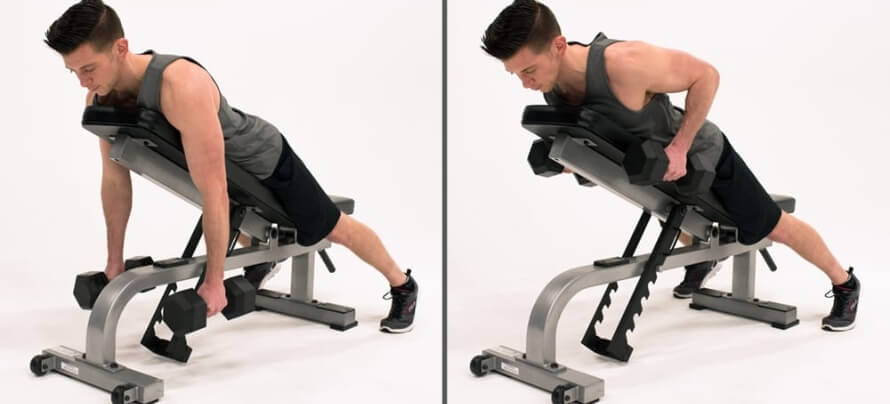
Set an incline bench to roughly a 30-degree angle. Grab a dumbbell in each hand, and lie prone on the bench with your feet on the floor and your arms extended toward the ground.
Pull the dumbbells upward until they’re by your sides, then reverse the movement and return to the starting position.
Variation 3: Kroc Row
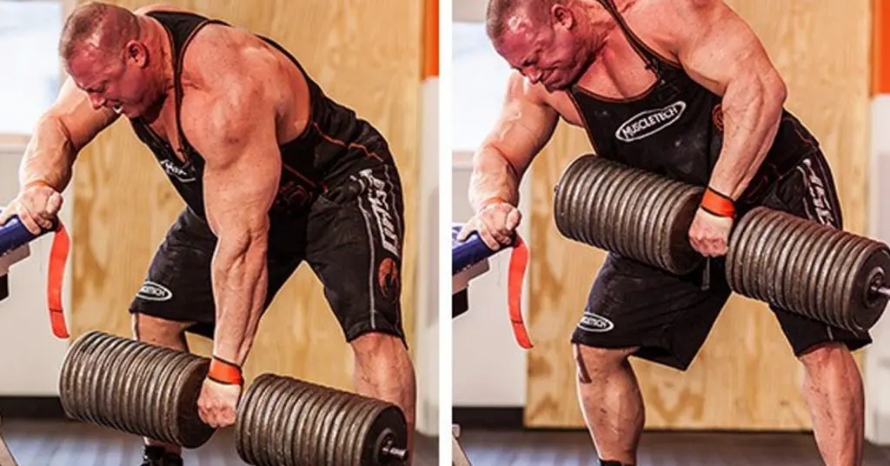
Set up like you would for a standard dumbbell row, but with your back slightly more upright. Pull the dumbbell straight upward until it touches the bottom of your rib cage, and focus on squeezing your shoulder blades together as hard as possible at the top of the rep. Reverse the movement and return to the starting position. At the bottom of the rep, let the dumbbell pull your shoulder down until you feel a deep stretch in your lats and upper back.
Tip: Thanks to the more upright back angle and the exaggerated contraction at the top of the rep, you can normally use heavier weights and higher reps with the Kroc row than you can with a more “strict” dumbbell row.
Variation 4: Dumbbell Renegade Row
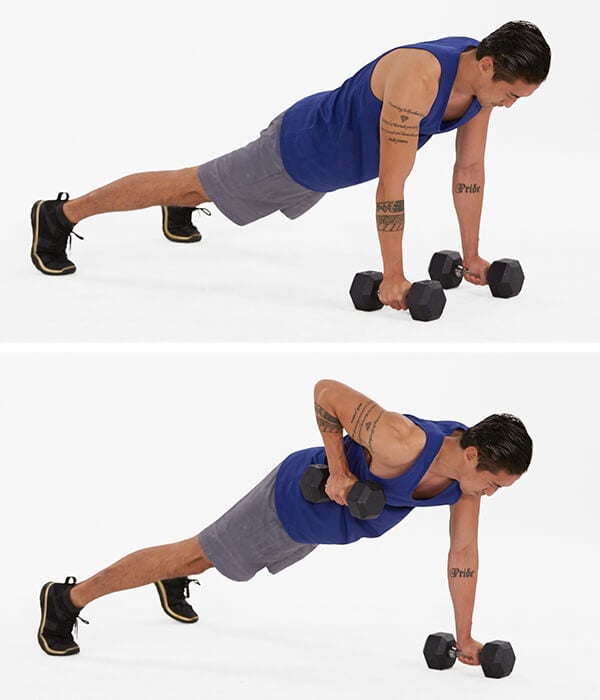
While holding a light dumbbell in each hand, get into a push-up position. Without twisting your body, shift your weight to your left side and lift the right dumbbell upward until it touches your torso. Reverse the movement and return to the starting position, then repeat the movement on your left side.
Variation 5: Dumbbell Upright Row
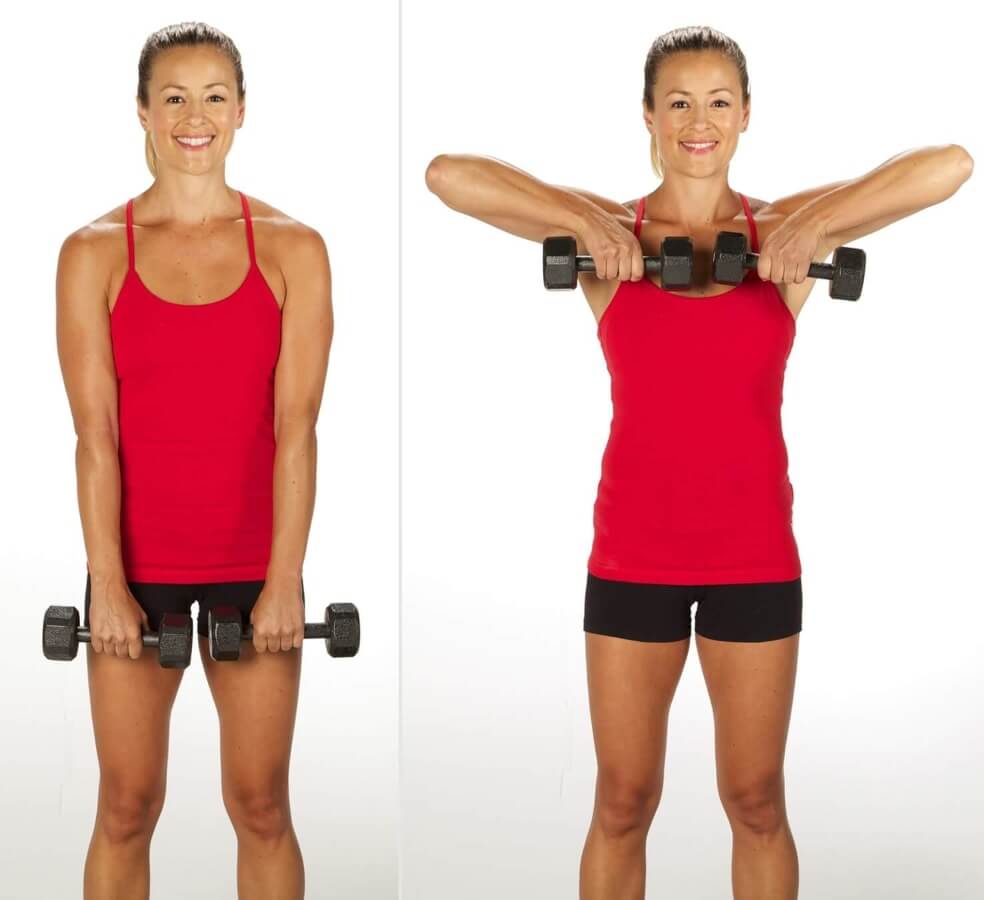
Stand up straight with a dumbbell in each hand. Hold the dumbbells so that they’re in front of your thighs, with your palms facing toward you. Lift the weights straight upward until they’re at the level of your lower chest, making sure to keep your elbows higher than your forearms throughout the movement. Reverse the movement and return to the starting position.










